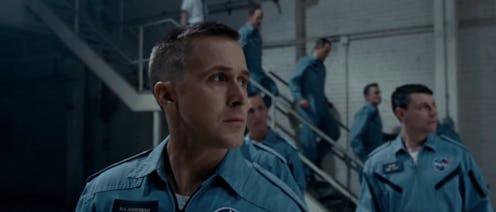Entertainment
How ‘First Man’ Brought The Neil Armstrong Few People Knew To Life
"If I were to write the short story of Neil [Armstrong] going to the moon, it would be about loss," First Man screenwriter Josh Singer tells me ahead of the film's release. And, so, that's what the movie is about. Yes, it's about the space race and rockets and an American hero, but Armstrong experienced an incredible amount of loss in his life and it shaped the man he was. For Singer and director Damien Chazelle (La La Land), it was essential that First Man be accurate, not just when it comes to the science and technology and history and biography of it all, but when it comes to who Armstrong was when he was alone.
Singer, who is wearing a NASA cap when we meet in New York City, researched Armstrong for four years while adapting the screenplay from James R. Hansen's biography, First Man: The Life of Neil A. Armstrong. ("I'm a particular bird in that I love to learn, so I will geek out on things as long as possible," Singer says.) Singer and Hansen worked together, including consulting with members of Armstrong's family, like his sons, Rick and Mark, and his ex-wife, Janet, who passed away in June, four months before the film's premiere.
"Neil was, as Jim [Hansen] would say, a emotionally tightly packaged man," Singer says. "He was not a guy who was easy to know." The screenwriter, who also wrote The Post and Spotlight, explains that figuring out who Armstrong was was one of the most challenging parts of writing the script — more than deciphering pages upon pages of mission control transcriptions.
There is a scene in the film that shows Armstrong (Ryan Gosling) finding out about the Apollo 1 tragedy, in which all three crew members, friends and colleagues of his, died during a fire on the spacecraft. "We initially scripted that that Neil hears the news and takes it somewhat calmly and then starts beating the phone against the receiver like, bam bam bam, with such anger and force and bloodies his hand," Singer says. "You know, big emotional moment." He then sent the script to Hansen and some of Armstrong's fellow astronauts. "They were like, 'No way, that's not Neil!'" Singer then came up with another idea: Armstrong hears the news while holding a drink. He squeezes the glass hard in anger, but doesn't realize until it cracks. This version got Hansen's approval.
In another example of Armstrong's withholding personality, the most heartbreaking scene (and it's a tight race, this film really does have a lot of loss) comes when Armstrong is shown going into a room alone and crying after his two-year-old daughter Karen's funeral. (Karen died as the result of a brain tumor in 1962.) And it's not just heartbreaking because a father is crying at his daughter's death, but because no one knows he's doing it — he completely hides his pain from his wife, Janet (Claire Foy) and son.
"Robert Pearlman, who's a space expert of sorts, said when he saw that in the film, he realized he was going to have to totally rethink everything he knew about Neil Armstrong," Singer says. "What a crazy statement. The fact that you see a man cry at the death of his two-year-old daughter and you have to rethink everything you knew about him? Why isn't that obvious? But it's not. He was that type of packaged, emotionally."
While Singer was meticulous about keeping everything in the film accurate to who Armstrong was, there is one part where speculation had to come into play: what Armstrong did on the moon when he had a moment to himself. "We focus on what you didn't know and what you haven't seen. And we were very intensely interested in what was Neil's experience," Singer says, "which is why our main focus was on this one moment that wasn't scripted, that wasn't in the mission plan, where he wanders over to the Little West crater and no one knows what he did." Spoilers for the movie ahead.
First Man uses the moment to show Armstrong leaving behind a bracelet that belonged to Karen. "The bracelet is conjecture that's not mine, it's Jim Hansen's," says Singer. Hansen, through speaking to Janet and to Armstrong's sister, June Hoffman, found that Armstrong leaving something of Karen's on the moon added up. "It's partially because of Neil's emotional journey, but also because this is something that's done pretty regularly," Singer explains of astronauts who have left things on the moon ever since. "Good enough for Jim, good enough for June, good enough for me."
This was the most major addition of something that isn't confirmed, but there are also, of course, things that the film leaves out. The biggest being a house fire the Armstrongs experienced during the time period shown in the film. The scene was actually shot, but "ultimately at the end of the day, it was a great character scene, but it was sort of off the spine of the mission," Singer says.
Singer's concern with the film's accuracy extends beyond the movie itself. He and Hansen also co-authored First Man — The Annotated Screenplay, which includes additional research and the full script with notes from the pair.
The film hits theaters on Oct. 12, but their work in staying true to who Armstrong was has already paid off when it comes to the people who matter most. "The highest compliment we've gotten is Mark [Armstrong's son], up in Toronto he said, 'People ask us all the time what was it like to grow up with the first man who walked on the moon,' he said, 'the film is now our answer.'"
